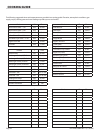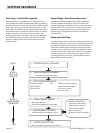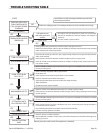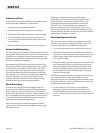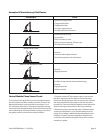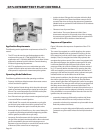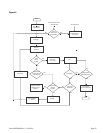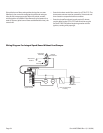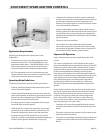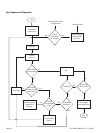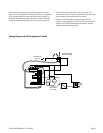
Page 30
Part # MCOSM06 Rev 1 (11/03/08)
SERVICE
Preliminary Check
The following visual checks should be made before trouble
shooting and after installation or maintenance.
1. Check power to the appliance and S86.
2. Manual shuto cocks in the gas line must be open.
3. Make certain all wiring connections are clean and tight.
4. First de-energize the system and wait at least one (1)
minute. This resets the module allowing a return to the
start condition.
5. Review the S86 system normal sequence of operation.
System Trouble Shooting
Start the system by setting the controller above the required
temperature. Observe the system response. Establish the type
of malfunction or deviation from the normal operation. Use
the S286 Intermittent Pilot system trouble shooting table to
check for normal system operation.
Use the table by following the instruction questions in the
box. If the conditions is true or okay (answers yes), go down
to the next box underneath. If the condition is not true of
not okay (answer no), go right to the next box alongside.
Continue checking and answering conditions in each box
encountered, until a problem and/or the repair is explained.
After any maintenance or repair, the trouble shooting
sequence should be repeated until the trouble shooting
procedure ends with a normal system operation.
Check Grounding
A common ground is required for the pilot burner, the
igniter-sensor, the GND terminal of the S86, and the main
burner. The main burner generally serves as the common
ground. If the ground it poor or erratic, safety shutdowns may
occur occasionally even though operation is normal at time
of check out. Therefore, if nuisance shutdowns have been
reported, be sure to check the grounding.
Note: If the ground circuit path is incomplete, the S86H
system control will allow one trial for ignition before going
into safety lock out.
Electric grounding connections at the pilot burner,
igniter/sensor and S86 must be clean and tight. If a lead
wire is damaged or deteriorated, use only No. 14 or 18
gauge moisture resistant thermoplastic insulated wire
with 105°C (221°F) minimum ratings as replacement.
Excessive temperature at the ceramic ame rod can also
permit electrical leak to ground. Examine the ame rod and
mounting bracket, and correct if bent out of position. Replace
igniter/sensor if insulator is cracked.
Check Spark Ignition Circuit
The electronic module and step-up transformer in the S86
provides a spark ignition at 30,000 volts (open circuit). This
circuit can be checked at the S86 module as follows:
1. Turn o the manual gas cock to prevent the ow of gas.
2. Disconnect the ignition cable at the S86 stud terminal to
isolate the circuit from the pilot burner/igniter/sensor, and
prepare a shot jumper lead using heavily insulated wire,
such as ignition cable.
3. Energize the S86 touch one of the jumper rmly to the S86
ground terminal (GND). Do not disconnect the existing
ground lead. Move the free end slowly toward the stud
terminal to establish a spark and then pull the lead wire
slowly away from the stud. Not the length of the gap at
which the arching stops.
CAUTION: Do not touch either the stripped end of the jumper
or stud terminal. This is a very high voltage circuit and
electrical shock can result. Perform the test immediately upon
energizing the system – before the S86H goes into safety lock
out and interrupts the spark circuit.
4. An arch length of 1/8" (3.2mm) or more indicates a
satisfactory voltage output. Replace the S86 if not arc
can be established or the maximum gap is less then 1/8"
(3.2mm), and the fuse and power to the S86 input terminal
was okay.



